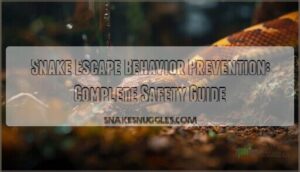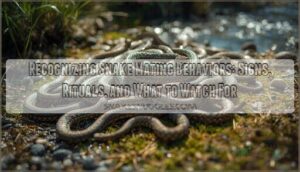This site is supported by our readers. We may earn a commission, at no cost to you, if you purchase through links.

That lifespan isn’t guaranteed, though. The difference between a corn snake that barely makes it to 10 and one that cruises past 20 comes down to the care decisions you make every single day. Temperature fluctuations, feeding schedules, humidity levels, and stress management all play measurable roles in whether your snake thrives for decades or struggles through a shortened life.
Understanding what influences longevity helps you give your corn snake the best shot at a full, healthy life.
Table Of Contents
Key Takeaways
- Captive corn snakes live 15-20 years on average (sometimes reaching 25-30 years), which is 200-300% longer than their wild counterparts who typically survive only 6-8 years due to predation and environmental pressures.
- Daily care decisions—including proper temperature gradients (75-85°F), humidity levels (40-60%), feeding schedules, and stress management—directly determine whether your snake thrives for two decades or struggles through a shortened lifespan.
- Overfeeding can reduce lifespan by up to 30% through obesity, while proper prey sizing (matching the snake’s body width), appropriate meal frequency (every 5-7 days for juveniles, 10-14 days for adults), and varied diet support the full 15-20 year potential.
- Breeding females should only reproduce every other year after age three since the egg-laying process is physically demanding and can shave years off their life, while males generally handle breeding better throughout their lifespan.
How Long Do Corn Snakes Live in Captivity?
Ever wondered just how long a corn snake can keep you company when they’re cared for at home? With the right Corn Snake Care and an ideal Snake Habitat, captive corn snakes can thrive for 15 to 20 years.
It’s not unheard of for them to reach 25 or even 30 years, making them outstanding companions in responsible Pet Ownership.
Corn Snake Lifespan
When cared for properly, your corn snake’s lifespan in captivity can be impressive. Most captive corn snakes live between 15 and 23 years, though some remarkable individuals have reached over 30 years. That’s a far cry from their wild counterparts, who usually survive just 5 to 10 years due to predation and environmental pressures.
Snake life expectancy hinges on several interconnected factors: diet quality, stable temperatures between 75–85°F, and consistent health monitoring all play significant roles. Genetic research shows that some bloodlines naturally live longer, but even the best genetics won’t overcome poor husbandry.
Understanding the aging process and environmental impact on corn snake lifespan helps you provide care that truly has an impact. To guarantee your pet thrives, it’s crucial to learn about proper snake care and apply it consistently.
Captive Vs Wild Lifespan
The difference between captive corn snake lifespan and wild mortality rates is striking. Your captive corn snake can live 15 to 24 years—some even hit 32 years with exceptional care—while wild individuals rarely make it past 6 to 8 years. That’s a 200% to 300% survival boost in captivity.
Why such a gap? Environmental factors tell the story. Wild corn snakes face constant predation from hawks, mammals, and competing species. Over 80% don’t reach breeding age. Habitat loss, road deaths, and mistaken identity killings shorten their odds further. In captivity, you control temperature, humidity, and food supply—eliminating the seasonal bottlenecks that crush wild populations. Understanding snake defense mechanisms is vital for providing the right care and environment for your pet.
| Habitat Comparison | Captivity | Wild |
|---|---|---|
| Average Lifespan | 15–24 years | 6–8 years |
| Maximum Record | 32+ years | ~10 years |
| Juvenile Survival | 90%+ | Corn snake longevity isn’t luck—it’s earned through attention to detail and unwavering commitment to their care |
- https://www.petmd.com/reptile/corn-snake-care-sheet
- https://www.oldest.org/animals/snakes/
- https://www.rspca.org.uk/adviceandwelfare/pets/other/cornsnake
- https://www.zenhabitats.com/blogs/reptile-care-sheets-resources/answering-the-most-asked-corn-snake-questions-zen-habitats
- https://a-z-animals.com/blog/corn-snake-lifespan-how-long-do-corn-snakes-live/








